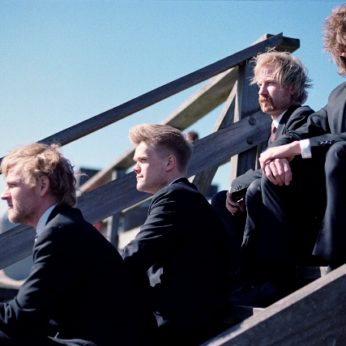Composer: Carl Nielsen (b. 1865 - d. 1931)
Performance date: 28/06/2014
Venue: St. Brendan’s Church
Composition Year: 1897/8
Duration: 00:31:01
Recording Engineer: Richard McCullough, RTE
Instrumentation: 2vn, va, vc
Instrumentation Category:String Quartet
Artists:
Danish Quartet (Frederik Øland, Rune Sorensen [violins], Asbjørn Nørgaard [viola], Fredrik Sjölin [cello]) -
[quartet]

Nielsen
came from Norre Lyndelse near the
of
His father Niels Jorgensen was a house painter who played the violin and
cornet. However, it was his mother Maren Kristine who gave the young Carl his
first three-quarter-sized violin. The boy taught himself a few melodies, which
he played to his father on his return home from military service.
Later,
Nielsen undertook private lessons from Carl Larsen, sexton in Odense Cathedral,
who recognised his obvious talent and helped in securing an introduction to
Niels Gade, head of
Conservatory. Nielsen entered the Conservatory in January 1884, graduating
three years later.
Nielsen’s
E flat Quartet had a difficult birth, having sent the first two movements to
his copyist he made final corrections to the remainder. En route to his copyist
again he encountered a dray with two horses, one of which had fallen over and
lay floundering with its legs in over the pavement. Nielsen jumped off his bike
and shoved his music roll into the hands of a young boy standing in the crowd, asking
him to hold it for a moment. It was only the work of a couple of minutes to get
the horse up on to its legs, but when he turned back the boy had vanished.
Scoreless he rode home in despair and neither the boy nor the manuscript ever
resurfaced..
The
opening Allegro con brio comes in an ABACABA structure with a rather expansive
main theme that is boldly assertive as it rises to the first violin’s highest
register. There is a brilliantly woven contrapuntal tapestry underneath, and
this remains a characteristic of the movement. A second subject is more subdued
while a third, heard initially on the cello, has a kind of pastoral air to it.
Nielsen’s development is built mainly on the first idea but his recapitulation
considers each of the principal subjects. The movement ends following a lengthy
coda.
After a
short introduction, the Andante sostenuto
has a hauntingly expressive hymn-like quality in its main theme heard on the
first violin. The feeling engendered becomes more impassioned as the movement
progresses but the tension is relaxed somewhat by the return of the main idea.
The second subject also rises in intensity but a lessening of its concentration
brings an ecstatic return of the hymn-like main theme heard now on the cello as
the first violin traces a delicate line above it.
The
first violin leads the playfully wayward Allegretto
pastorale over the other instruments’ delightfully imaginative
accompaniment. The Trio section, following this mild-mannered sequence, is a
remarkable Presto where the first
violin gallops over a series of triplets interrupted by double-stopped chords
from the other players. This disruptive intrusion subsides into a delicately
lyrical interlude before the return of the main Allegretto pastorale.
The
Finale is built around the rousing Allegro
coraggioso (courageously) march heard at the start and a contrasted lyrical
subject that appears once the main theme has been fully stated. Nielsen’s
genius comes to the fore in his transforming the opening march into an engaging
pizzicato fugal intermezzo. In time there is a full recapitulation of both
themes and another lengthy coda, based mainly on the opening march, brings the
Quartet to its brilliant conclusion.
Copyright © 2025 West Cork Music. All rights reserved.
Designed and developed by Matrix Internet